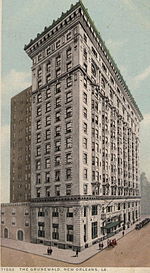Canal Street, New Orleans

Canal Street (French: rue du canal) is a major thoroughfare in the city of New Orleans. Forming the upriver boundary of the city's oldest neighborhood, the French Quarter or Vieux Carré, it served historically as the dividing line between the colonial-era (18th-century) city and the newer American Sector, today's Central Business District. Up until the early 1800s, it was the Creoles who lived in the Vieux Carré. After the Louisiana Purchase (1803), a large influx of other cultures began to find their way into the city via the Mississippi River. A number of Americans from Kentucky and the Midwest moved into the city and settled uptown. Along the division between these two cultures, a canal was planned. The canal was never built but the street which took its place received the name. Furthermore, the median of the street became known as the neutral ground, acknowledging the cultural divide. To this day, all medians of New Orleans streets are called neutral grounds.One end of Canal Street terminates at the Mississippi River. Often called "the foot of Canal Street", at the riverfront the Canal Street Ferry offers a connection to the Algiers Point neighborhood, an older, 18th-century portion of the larger Algiers section of New Orleans. Canal Street's other terminus is in Mid-City at a collection of cemeteries. Slightly offset from the Mid-City end is the beginning of Canal Boulevard, which extends to the shore of Lake Pontchartrain via the Lakeview neighborhood. Throughout its length, Canal, which runs east and west, serves as a dividing line for cross streets running north and south; although the New Orleans layout follows the Mississippi River. The street has three lanes of traffic in both directions, with a pair of streetcar tracks in the center. Canal Street's downtown segment serves as the hub of the city's public transit system or RTA, with numerous streetcar and bus route terminals. (Of note, it is the home of the Canal Streetcar Line, operated by the RTA.) Canal Street is often said to be the widest roadway in America to have been called a street, instead of the avenue or boulevard titles more typically appended to wide urban thoroughfares.
Excerpt from the Wikipedia article Canal Street, New Orleans (License: CC BY-SA 3.0, Authors, Images).Canal Street, New Orleans
Canal Street, New Orleans Storyville
Geographical coordinates (GPS) Address Nearby Places Show on map
Geographical coordinates (GPS)
| Latitude | Longitude |
|---|---|
| N 29.9554 ° | E -90.0721 ° |
Address
Canal Street 1019
70112 New Orleans, Storyville
Louisiana, United States
Open on Google Maps











